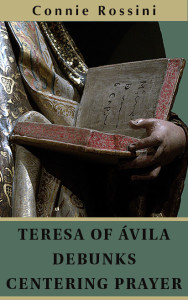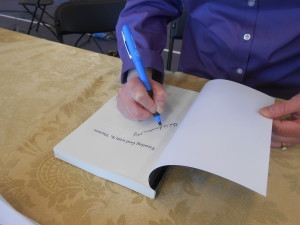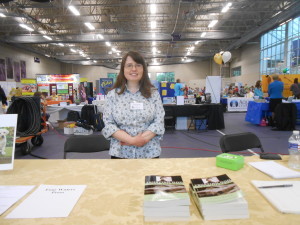Connie Rossini's Blog, page 9
July 28, 2015
More on the prayer of union
Since I have been studying and writing a lot about Centering prayer lately, I can’t help but compare it to the prayer of union, which occurs in the fifth mansions. I wrote about the prayer of union back in May, before my blogging break. Let’s look at it again.
1. CertitudeAs I said last time, the most important sign Teresa of Avila gives that a soul has truly experienced union with God is certitude. Nothing and no one can shake her confidence that her experience was real. It is unforgettable, life-changing.
Let’s contrast this with counterfeit types of contemplation such as Centering Prayer. Fr. Thomas Keating writes:
Let go of sensible and spiritual consolation. When you feel the love of God flowing into you, it is a kind of union, but it is a union of which you are aware. Therefore, it is not pure union, not full union.”(Open Heart, Open Mind, Ch. 7)
For Fr. Keating, one of the originators of Centering Prayer, the deepest union with God is completely hidden from the soul. For Teresa, the truer the union, the less one can ignore it or explain it away.
One might be tempted to ask how a practitioner of Centering Prayer can claim that it is a good preparation for true union, since he can never know if he has experienced union. Presumably, no one else who has ever practiced Centering Prayer can say for certain that he has reached union with God either. So how can we know that the method works?
2. Beyond understandingHowever, this certitude of the soul’s does not mean she understands what is happening. She is like someone blind and deaf. She enjoys God, without being able to figure out exactly what’s happening. On this point, Teresa and Fr. Keating would agree. However, Teresa believes that understanding will come, just not until the seventh mansions.
3. Sustaining the prayerIn earlier stages of prayer, such as acquired recollection, Teresa instructs us to sometimes say a word of prayer to re-fan the flames of love when our recollection waivers. Centering Prayer advocates often point to this as evidence that their teaching is in accord with hers.
But Teresa says that the prayer of union is different. She says in part:
During the time that the union lasts the soul is left as though without its senses, for it has no power to think even if it wants to.” (Interior Castle 5.1.4)
No method can help the soul here. The union comes through God’s power alone, and is sustained by his power alone. The soul is powerless. Practicing Centering Prayer by returning to the “sacred word” one has chosen to repeat would be nearly impossible.
4. Attaining this unionHow can we reach this high state of spirituality? Teresa notes that Carmelite nuns enter the cloister for just this purpose, to seek God in prayer and contemplation. Yet reaching union is not a sure thing. Why not?
Few of us dispose ourselves that the Lord may communicate it to us. In exterior matters we are proceeding well so that we will reach what is necessary; but in the practice of the virtues that are necessary for arriving at this point we need very, very much and cannot be careless in either small things or great.” (5.1.2)
Now, that doesn’t mean it’s hopeless. No matter how weak we are, she says, we just have to give him whatever we have. “He doesn’t make it impossible for anyone to buy his riches.” In this, she sounds remarkably like St. Therese. (Or, rather, Therese sounds like her.)
The more we give God, the more he will give himself to us. So if we want to attain union, we must withhold nothing from him.
This contrasts dramatically with Fr. Keating’s view that “Contemplation… is not so much a gift as a given. (Open Heart, Open Mind 120)”
5. Infused knowledgeHere is another striking difference with counterfeit types of contemplation. True union contains a great paradox. Even though the soul cannot think at all while united to God, she still learns things about God during union.
Teresa says that she learned through the prayer of union that God was “in all things by presence, power, and essence.” A poor spiritual director told her she was wrong, but she was so convinced that she consulted others. Learned men told her she was right. We must remember that Teresa had no theological training. She learned this truth directly from God, not even through meditating on the Scriptures. It was after experiencing union that she suddenly knew this.
So, even though the soul cannot think or ponder while in union, God still infuses her with knowledge as he desires.
In contrast, Fr. Keating insists on an ever-greater obscurity as one grows closer to God. He says that the mature Christian soul neither knows who or what God is nor desires to do so (Open Heart, Open Mind, 66).
There is much more to talk about in the fifth mansions. But I think we will leave the rest for next time.
Connie Rossini
Other posts you may like
July 22, 2015
Centering Prayer’s errors about God
I recently decided to dig deeper into understanding Centering Prayer, so I could advise readers on it. I bought Fr. Thomas Keating’s book Open Heart, Open Mind and wrote a review that will appear at SpiritualDirection.com in September.
But one blog post was not enough. The errors in this book were so many and so serious, I decided it needed a more thorough response. So I am writing a quick ebook called Teresa of Avila Debunks Centering Prayer. It should be ready for publication in a couple of weeks. Here is an Excerpt, on Centering Prayer’s errors about God. It still needs to be edited, so please excuse anything my editor/husband would refer to as “infelicities.”
The first error concerns the distinction between God and man.
Here is a key point of contrast between New Age and Christianity. So much New Age literature is shot through with the conviction that there is no divine being ‘out there’, or in any real way distinct from the rest of reality. From Jung’s time onwards there has been a stream of people professing belief in ‘the god within’. Our problem, in a New Age perspective, is our inability to recognise our own divinity, an inability which can be overcome with the help of guidance and the use of a whole variety of techniques for unlocking our hidden (divine) potential. The fundamental idea is that ‘God’ is deep within ourselves. We are gods, and we discover the unlimited power within us by peeling off layers of inauthenticity. The more this potential is recognised, the more it is realised, and in this sense the New Age has its own idea of theosis, becoming divine or, more precisely, recognising and accepting that we are divine.”
Perhaps the greatest error, and the one most widely known, is Keating’s blurring of the distinction between God and man. Accused of pantheism, he and other Centering Prayer advocates responded that they teach panentheism. What is panentheism? The Stanford Encyclopedia of Philosophy notes that it is an attempt to find a middle ground between a theistic view that sees God as only transcendent, and a pantheistic view that sees God as only immanent. However, there is no fixed set of beliefs for panentheism. Therefore, invoking the term cannot settle the question: what do Thomas Keating and his movement teach about who God is?
Here is just one quote among many from Keating’s book Open Mind, Open Heart that shows the problem:”God and our true Self are not separate. Though we are not God, God and our true Self are the same thing” (158).
Similarly, in a Youtube clip of a movie about Keating’s life, the abbot says:
The beginning of the spiritual journey is the realization that there is a Higher Power or God, or to make it as easy as possible for everybody, that there is an Other; Capital O. Second step: to try to become the Other; still a Capital O. And finally, the realization that there IS no Other; you and the Other are One. Always have been, always will be. You just think that you aren’t.”
And in a frank online interview, Keating seems to be saying that the only thing holding him back from embracing a Hindu way of speaking about the divine is what Christianity “requires” him to say. In other words, he suspects that there is no real distinction between Buddhist, Hindu, and Catholic views, but only distinct traditions and ways of using words to talk about mystical realities.
In orthodox Catholic teaching, even at the highest stages of union with God, the soul remains a distinct personality.
What does St. Teresa of Avila say on this matter? Here is a section from the beginning of her classic work Interior Castle:
As I see it, we shall never succeed in knowing ourselves unless we seek to know God: let us think of His greatness and then come back to our own baseness; by looking at His purity we shall see our foulness; by meditating upon His humility, we shall see how far we are from being humble.
There are two advantages in this. First, it is clear that anything white looks very much whiter against something black, just as the black looks blacker against the white. Secondly, if we turn from self towards God, our understanding and our will become nobler and readier to embrace all that is good: if we never rise above the slough of our own miseries we do ourselves a great disservice.
Keating might respond that Teresa is in this passage using the word self to mean what he calls our false self. He never identifies our false self with God, only our true Self. Such a distinction is unknown to Teresa, however. To her, the self is one thing and God is something else, from the lowest depths to the heights of spirituality.
In another passage she speaks about entering into oneself, but very clearly distinguishes that self from God:
It is absurd to think that we can enter Heaven without first entering our own souls — without getting to know ourselves, and reflecting upon the wretchedness of our nature and what we owe to God, and continually imploring His mercy. The Lord Himself says: ‘No one will ascend to My Father, but by Me’ (I am not sure if those are the exact words, but I think they are) and ‘He that sees Me sees My Father.’ Well, if we never look at Him or think of what we owe Him, and of the death which He suffered for our sakes, I do not see how we can get to know Him or do good works in His service.
We will return to this idea when we consider Centering Prayer’s errors concerning sin and redemption.
Connie Rossini
Jesus Christ: Bearer of the Water of Life, 3.5.
http://plato.stanford.edu/entries/pan.... Accessed 7/10/15.
You and the Other (with a Captila O), https://www.youtube.com/watch?v=Rd2LP..., accessed 7/10/15.
http://www.livingrosaries.org/intervi..., Accessed 7/10/15.
Interior Castle, translated by E. Allison Peers. First Mansions, Ch. 1.
Interior Castle, Second Mansions.
Other posts you may likeJuly 14, 2015
Contemplation aboard the Dawn Treader

After a long break, I am writing another post for my series “Finding God in Children’s Literature.” The Voyage of the Dawn Treader by C. S. Lewis has been one of my favorite children’s books since I first read it in fourth grade. Recently I found myself pondering its profundity during Mass. Not the worst way to be distracted from the liturgy. Let me share what your kids can learn about the spiritual life by sailing along with King Caspian and his companions.
To understand Dawn Treader you must understand where it gets its name. C. S. Lewis loved to make references to the Psalms in his works. Here is the first part of Psalm 139 from the New American Bible:
LORD, you have probed me, you know me:
you know when I sit and stand;
you understand my thoughts from afar.
You sift through my travels and my rest;
with all my ways you are familiar.
Even before a word is on my tongue,
LORD, you know it all.
Behind and before you encircle me
and rest your hand upon me.
Such knowledge is too wonderful for me,
far too lofty for me to reach
Where can I go from your spirit?
From your presence, where can I flee?
If I ascend to the heavens, you are there;
if I lie down in Sheol, there you are.
If I take the wings of dawn
and dwell beyond the sea,
Even there your hand guides me,
your right hand holds me fast.
If I say, ‘Surely darkness shall hide me,
and night shall be my light’
Darkness is not dark for you,
and night shines as the day.
Darkness and light are but one.”
For a lengthy discussion about symbolism and analogy, challenge your kids to find as many themes from this psalm as they can in the novel.
Where is God?Aslan does not appear as much in this novel as he does in some of the other Narnia books. However, he is always in the background. His reach is everywhere–even into a non-believing household in England. He appears on the Island of Voices after Lucy recites the spell. He speaks to her through the albatross. He is the Lamb that meets the children at the end of their trip.
The journey–obstensibly to find the lost lords–becomes a journey towards Aslan’s country, continuing even after the last lords have been found. We could say it shows a longing for the Beatific Vision. Can the soul reach union with God without dying? Reepicheep’s poem holds the answer:
From meditation to contemplationWhere sky and water meet,
Where the waves grow sweet,
Doubt not, Reepicheep,
To find all you seek,
There is the utter East.”
But if the journey ends in divine union, it begins with much more mundane things. In fact, it begins with an ugly painting in an extra bedroom. Here again we see God’s omnipotence. He is everywhere and can use anything to accomplish his purpose.
I like to see a more specific meaning in the painting too. Spiritual writers have long suggested using images (paintings, holy cards, icons, or statues) to help them to pray. Even Solomon’s temple was covered with pictures of the cherubim.
In Christian prayer, the soul must act. She [the soul] must do all within her power to think about and love God. She uses what is available. She meditates on creation or gazes at a holy picture. Or perhaps, like Lucy and Edmund at the beginning of the novel, she reminds herself of all the wonders God has done in the past. She repeats God’s promises of future joy. She talks about him whenever she can.
In the end, only God can draw a soul to himself. He must step in to do the work the soul cannot do. He reaches out, takes hold of the soul, and immerses her in his own life. Three children get a dunking, and only two of them like it.
At first, everything seems magical and beautiful (to Lucy and Edmund, anyway). But soon the ship meets with danger. There are dragons, storms, and temptations. The children are nearly sold into slavery. They encounter terrible darkness. And they eat a feast from the heavens.
Doesn’t this remind you of the spiritual life?
They persevere. The water becomes sweet. The sun now acts as another symbol of God. It grows bigger and brighter. The travelers no longer need much food or drink as they are bathed in its light. They drink only the sweet water which is like liquid sunlight. They are becoming detached from everything they left behind. Caspian almost abdicates because he does not want to go back to the life he lived before.
Now they can look at the sun without hurting their eyes. They are beginning to experience union with God. Reepicheep enters his coracle and sails to Aslan’s country.
Voyage of the Dawn Treader is an excellent resource for teaching your children about the spiritual life.
Connie Rossini
Other posts you may likeJuly 7, 2015
Spiritual freedom in 21st century America
Liberty Bound? (My adaptation of an old poster for Liberty Bonds.) No one can rob you of true freedom.
What does it mean to be free in America today? Religious freedom faces many threats. What about spiritual freedom? Can we still be free, even if we should lose all our rights?
Western culture now interprets freedom as license. Freedom means being able to do whatever one wishes without anyone standing in one’s way. Verbal criticism is discrimination or hate speech. We cannot remain silent. We cannot respectfully excuse ourselves. We must celebrate immoral behavior, by force when necessary.
June 2, 2015
Welcome (back) to my blog
Signing Trusting God with St. Therese
Preparing to speak on Working with Your Child’s Temperament. (Notice how I tried to match my blog?)
My lovely St. Therese poster (framed by my neighbor) and coming attractions.
A Spiritual Growth Plan for Your Choleric Child. Released May 15.
Friday night at the Curriculum Fair
I have several issues to address quickly today. First, if you have been missing my posts for the last two months, I’m so sorry! In late March I sent out a survey so that I could segment my subscriber list. This means that I am trying to notify people about my posts according to their interests. I have 3 categories of posts now: Homeschooling and Parenting; Spirituality for Adults; and Books, Videos, and Events. Only a third of my subscribers completed the survey. Those who didn’t were supposed to continue receiving everything. However, I’ve learned from a few readers that instead they’ve been receiving nothing.
I think I’ve fixed the problem. So sorry if you’ve been missing my posts when you wanted to receive them!
If you wish to limit the emails you receive to one category, you can update your preferences by using the link at the bottom of your emails from me, or the signup box on my blog’s sidebar.
A successful homeschool conferenceWelcome to all the new subscribers from the Minnesota Catholic Home Education Conference and Curriculum Fair!
I gave two workshops at the conference: Homeschooling Help from St. Therese and Working with Your Child’s Temperament. Both went very well. After the second, I had more questions that there was time for. If you missed the talks and would like to hear them, you can order CDs soon. I am just waiting for a link to the company who records them.
Thank you for your prayers for this event. I met a few of my subscribers in person. I also connected with other writers. I talked with many parents who are striving to raise godly children. I even sold some books! It was great fun.
A Spiritual Growth Plan for Your Choleric ChildIf you have been missing my emails, you probably missed the announcement about my second book, which came out on May 15. A Spiritual Growth Plan for Your Choleric Child is available in paperback and as an ebook. You can find all my books and their details on my Book Table page.
If you have friends or family who could benefit from this book, please pass the word onto them. And if you have a homeschool or parenting blog, I’d be happy to send you a review copy. Just email me at crossini4774 at comcast dot net.
I have just started working on the second book in the series, on the phlegmatic child. But that brings me to my next point.
Blogging sabbaticalI have been going strong with my writing since long before I published Trusting God with St. Therese. My husband has asked me to take the month of June off from working on any books. Our home needs some attention!
I decided to also take a break from my weekly blogging here. That will give me time to write a few columns for SpiritualDirection.com and focus on getting the word out about the choleric child book. And do some laundry. (I’m phlegmatic, remember?)
My next post here after today will be on July 7.
What can you do in the meantime? Here are some ideas:
Read the posts you missed getting, or that you haven’t had time to readStart at the beginning of my series on Interior Castle and read them through to the fifth mansionsVisit my new Homeschool and Parenting pageRead my original posts on trust that were the start of my first bookRead one of my books!Take a break from the internet and get some fresh air and exerciseDon’t worry, I have lots of ideas for writing when I come back! Please don’t go away permanently. We’ll reconnect soon.
Connie Rossini
Other posts you may likeMay 27, 2015
Homeschooling help from St. Therese
I’m gearing up for the Minnesota Home Education Conference and Curriculum Fair this Friday and Saturday at the University of St. Thomas in St. Paul. I will be speaking on Homeschooling Help from St. Therese, and Working with Your Child’s Temperament. Here are the slides for the St. Therese talk. I posted the slides for the Temperament talk two weeks ago.
These are 7 lessons we can learn from St. Therese’s time as assistant novice mistress in Carmel. Therese was a mother to the women under her direction, although many of them (including her sister Celine) were older than her. She teaches us to humble ourselves before God, realizing we cannot succeed as parents or educators of our children without His help. We must trust Him for everything, including the results.
In the meantime, we are His servants alone. We do not serve our kids, our neighbors, or a method or curriculum. We are only answerable to Him. And so are our friends and fellow homeschoolers.
Please pray for the success of my talks. I am sure I will have lots of stories and photos to share soon. If you are going to the conference, please stop by and introduce yourself!
Connie Rossini
Other posts you may likeMay 19, 2015
5th Mansions: the prayer of union

Statue of St. Teresa of Avila at Carmelite Monastery, Varroville, NSW, Australia. The prayer of union leaves the soul with desire only for God.
Souls generally remain in the fourth mansions of the Interior Castle for years. But for those who are raised beyond them, even greater intimacy with God lies ahead. Today we begin exploring Teresa of Avila’s fifth mansions.
The prayer of union begins in the fifth mansions. How does it differ from the prayer of quiet? As I said last time, the prayer of quiet primarily involves the will. In the prayer of union, the intellect, the memory, and the imagination also share in contemplation.
The sign of true unionSt. Teresa says true union always produces a sign of its authenticity. That sign is the soul’s certitude. She knows just as surely as if she had been speaking to Christ in the flesh that she has been in union with God. Even when spiritual directors or companions try to persuade her otherwise, she doesn’t believe them.
If you don’t have this certainty, Teresa says, you may have had some kind of authentic mystical experience, but it wasn’t union (Interior Castle V, 1:11).
Years later, the soul remembers the exact time and place of the union. Its impression never fades.
What is it like?Teresa believes that most souls who are faithful in the fourth mansions will be brought at least to the threshold of the fifth. But there are many different types of union in the fifth mansions, and different souls will experience various types.
Teresa writes:
During this time of union, [the soul] neither sees, nor hears, nor understands, because the union is always short and seems to the soul even much shorter than it probably is.” (V, 1:9)
Later, in the seventh mansions, the soul will understand the union. Now it is struck deaf and dumb, not even thinking or imagining during the time of prayer, but just enjoying union with God.
Comparing the delights of union with mere earthly delights, she says, is like comparing something you feel in the marrow of your bones with material you feel with your skin.
Earlier, she says:
The effects of unionThere is no need here to use any technique to suspend the mind since all the faculties are asleep in this state–and truly asleep–to the things of the world and to ourselves. As a matter of fact, during the time that the union lasts the soul is left as though without its senses, for it has no power to think even if it wants to. In loving, if it does love, it doesn’t understand how or what it is it loves or what it would want. In sum, it is like one who in every respect has died to the world so as to live more completely in God.” (V, 1:4)
She describes the soul as a silkworm. Before this union, the soul is like a fat, ugly worm. Afterwards, it is like a beautiful butterfly. It doesn’t even recognize itself. Its old self has died and it is completely made new.
This soul has a deep peace, deeper than any it has experienced before. At the same time, the soul suffers greatly at the sight of anyone offending God. This suffering does not affect its peace, yet it is deeper than any suffering it has experienced before, “for it seems that the pain breaks and grinds the soul into pieces” (V, 2:11).
“Almost each time [the soul experiences union] it gains new treasures” (V, 2:7). Detachment, desire to suffer for God and do penances, and contempt for the world all grow exponentially. Everything but God becomes a burden to it.
We’ll discuss some other aspects of the prayer of union next week.
Connie Rossini
Other posts you may likeMay 15, 2015
Spiritual help for your choleric child!
May 5, 2015
Life in Teresa’s fourth mansions
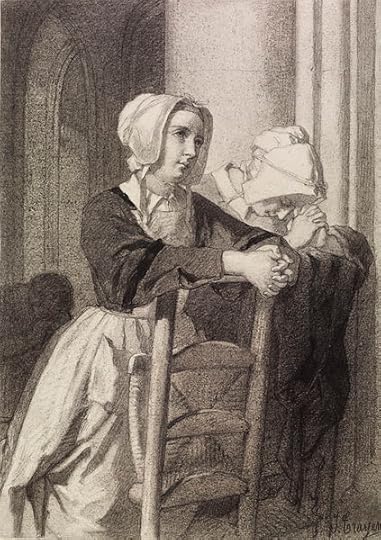
Woman Praying in Church by Jean-Baptiste Jules Trayer (Wikimedia Commons).
How should a person behave when he enters the fourth mansions? How should he act throughout the day? How should he pray?
First, let’s look at our behavior during prayer. As I have said (some might say ad nausuem) contemplative prayer is a gift from God. It does not come from the soul’s willing it or applying any technique.
Spiritual growth through the seven (groups of) mansions is gradual. Contemplative prayer begins subtly. It usually grows slowly deeper. Infused recollection blends into the prayer of quiet, which blends into the union of the fifth mansions.
A soul in the fourth mansions will probably not experience contemplation every time she prays–at least not at first. What should she do? She should not try to produce contemplation, since that’s impossible. Instead, she should go back to meditating on Sacred Scripture, affective prayer, or acquired recollection.
On the other hand, if God gives the soul contemplation, she should not try to force herself to meditate. She will find it impossible anyway.
In Way of Perfection, Teresa tells us how to behave during contemplative prayer:
The most we should do is occasionally, and quite simply, to utter a single word, like a person giving a little puff to a candle, when he sees it has almost gone out, so as to make it burn again.” (Ch. 31)
Remember, she is not saying that the repeated word produces the prayer. This is her recommendation for someone already given this prayer by God.
Growth in virtueHow does the soul advance in the fourth mansions? Teresa cites the following effects of this prayer:
no more fear of Hell or of the ill effects of penancesdesire for suffering and patience in itwithdrawing from all worldly delightsgrowth in all the virtuesAs Fr. Thomas Dubay notes in Fire Within, these effects, like the prayer itself, are infused (see p. 89). For example, in the third mansions you might meditate on the need for humility, make resolutions, and strive throughout the day to practice it, making some progress. In the fourth mansions, you may find you have taken a huge leap forward in humility even though you haven’t been thinking about it for some time.
If you do not experience a mysterious growth in virtue and detachment, that is a sign your prayer is probably not infused. Whatever other signs you think you have to convince you that you are in the fourth mansions, if you don’t desire God more and find it suddenly easier and more satisfying to do his will in even little things, you are probably not as advanced as you think you are.
Of course, like the prayer itself, this infused virtue comes gradually. If you experience contemplative prayer once or twice, you will probably notice a difference in your attitude and in your ability to do God’s will. But you must respond to any grace God gives you. You must work even harder to love God and your neighbor so that you can continue to grow.
If you are not sure whether your prayer is infused, try to consult a good spiritual director or knowledgeable priest.
Don’t expect raptures yetSince one reader asked me last time if the prayer of quiet was the same as ecstasy or rapture, I’ll briefly address this too.
Teresa says that some people who are psychologically impressionable and who may be physically weakened by penance, will swoon when they experience the prayer of quiet. They think they are experiencing rapture, which belongs to the late fifth and sixth mansions. What is really happening is that they are giving way to their own weakness. The remedy she says, is less time spent in prayer and less penance. They should try to serve God in an active life instead.
In the fourth mansions, the will experiences contemplation. The intellect gradually begins to take part in it. But the imagination and memory, as well as the body, are still in command of themselves (as much as they ever were). They will begin to feel the effects of contemplation as the soul experiences the prayer of union.
Connie Rossini
Other posts you may likeApril 28, 2015
Why canonize St. Therese’s parents?
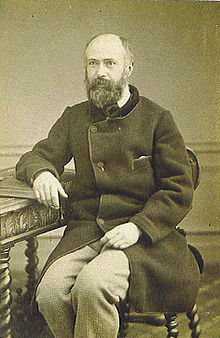
Blessed Louis Martin. Photo in public domain form Wikipedia Commons.
Recent reports from the Vatican indicated that Blessed Louis and Zelie Martin, parents of St. Therese of Lisieux, will be canonized in October.


